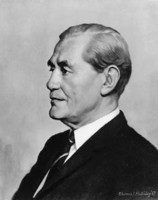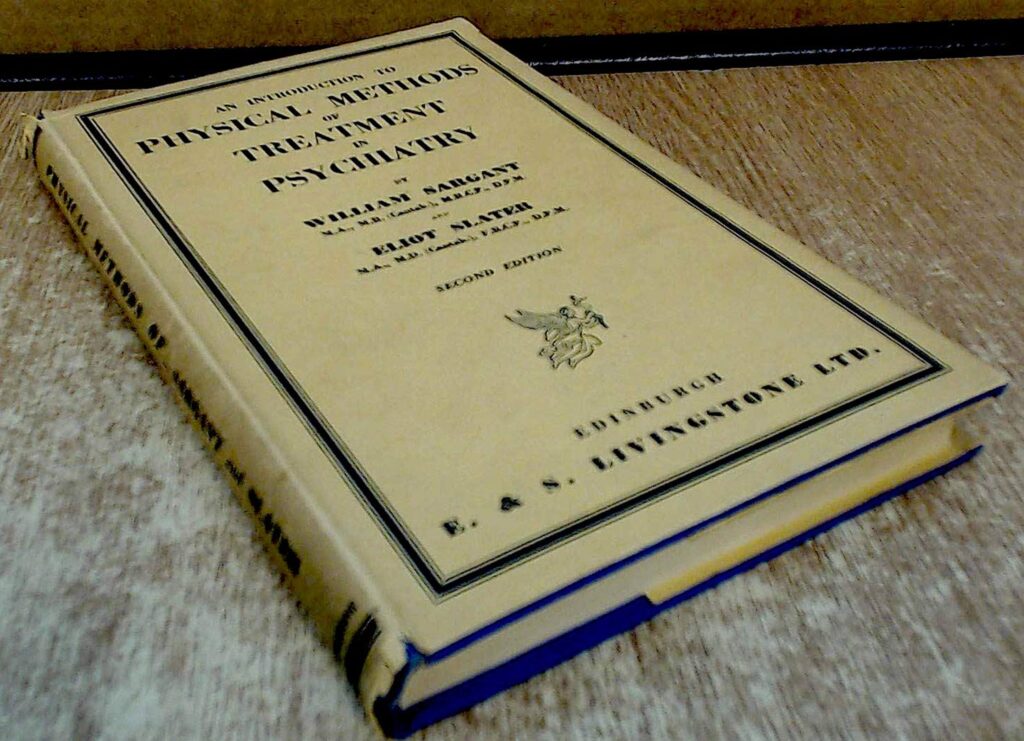JMS Pearce
Hull, England
 |
| Figure 1. William Sargant. Photo by Edward Irvine Halliday, 1967. © National Portrait Gallery, London. Fair use. |
After the innovative psychology of Freud, Jung, and Adler there was little progress in knowledge either of psychological or organic mechanisms, or their treatment.1 Few psychiatrists had postgraduate training in clinical organic medicine, but William Walters Sargant (1907–1988) was an exception, trained as a physician and famed for physical treatments of mental illnesses.
He was born in Highgate, London. His mother was Alice, née Walters, his father Norman Sargant, a fervent Methodist. At preparatory school he was thrashed for rebelliousness but became head of house and captain of football. He was huge by any standards in stature and charisma.2 At The Leys School, Cambridge, he was head of house, captain of most sports teams, and decided on medicine as his career. At St John’s College, Cambridge he captained the rugby team and was president of the Cambridge University Medical Society. He won a football scholarship to St Mary’s Hospital, London, where he became captain of rugby and played for the prestigious Barbarians.
He graduated in 1930 and was house surgeon at St Mary’s to both the versatile, eccentric Dickson Wright, and to the former Olympic sprint medalist Lord Arthur Porritt. After working on the medical unit he was appointed the youngest medical superintendent and passed the MRCP examination (1933). After this rapid ascent, in 1934 he fell ill with depression,2 which he later attributed to tuberculosis, and was briefly a patient in a mental hospital. At this time such illness was regarded unacceptable for a future teaching-hospital physician.
On this account Sargant resigned from St Mary’s to work as a locum at Hanwell Lunatic Asylum. There he was appalled by the poor standards of treatment of the incarcerated psychiatric patients. In 1935 Professor Edward Mapother, a staunch proponent of physical treatments for mental illness, invited him to join the staff of the Maudsley Hospital, which became the Institute of Psychiatry in 1948. Sargant’s charismatic zeal, boldness, and ability soon became apparent.2,3 He passed the Diploma in Psychological Medicine (DPM) in 1936. Unafraid of using unconventionally high doses, he used amphetamines for depression; insulin coma therapy for schizophrenia (subsequently modified, and eventually found ineffective)4; and electroconvulsive therapy (ECT) for refractory depression and catatonia. He replaced bromides with barbiturates for sedation and investigated anorexia nervosa and the physiological basis of depression. In 1938, he was awarded a Rockefeller fellowship to Harvard where he studied hyperventilation syndromes.
At the outbreak of war, he returned to England to work with Eliot Slater at the Maudsley Hospital’s neurosis unit, Sutton Emergency Hospital, later Belmont Hospital. The Maudsley then had a group of eminent psychiatrists who had fled from Nazi Germany: Alfred Meyer, Willy Mayer-Gross and Eric Guttmann. Psychological casualties were abundant. Sargant reported: “Many were suffering from acute hysteria, reactive depression, functional loss of memory, or of the use of their limbs, and of a variety of other psychiatric symptoms which one would see in such abundance only during a war or after an earthquake or railroad accident, when even perfectly normal people are apt to break.”5
Psychotherapy was widely used but proved time consuming and often ineffective. Sargant saw huge numbers of acutely disturbed shell-shocked soldiers.2,6 With HJ Shorvon he used acute sedation and abreaction with thiopentone, amylobarbitone, and ether.2,7 His methods proved successful for many if not for all such cases. In effect he had rediscovered the technique of cathartic abreaction, originally used by Freud in female hysteria in the 1890s.
 |
|
Figure 2. An Introduction to Physical Methods of Treatment in Psychiatry. |
He used frequent electroconvulsive therapy for depression— St Thomas’ alone reported 3000 attendances at its outpatient electroshock clinic per year. And, he used Walter Freeman’s new modified leucotomy, with cuts restricted to the inferior frontal quadrant, in those with good premorbid personalities for intractable psychosomatic states, and in anxiety and depressive states in obsessive personalities.8
All these treatments were controversial but no treatment of possible benefit was neglected. He published An Introduction to Physical Methods of Treatment in Psychiatry (Fig 2) with Eliot Slater in 1944.9 It had a profound influence on post-war psychiatry and ran to five editions.2 He enthusiastically prescribed monoamine oxidase inhibitors and tricyclic antidepressants discovered in the 1950s.10
He suggested that in war neurosis a process resembling Pavlovian conditioning was seen and that the success of physical methods of treatment indicated that physiological processes played a considerable part in the development of an acute neurosis.
His busy schedule was interrupted by pneumonia complicated by infectious hepatitis. While convalescing, he read Wesley and Pavlov, and finally published The Battle for the Mind, in 1957, which had a lasting influence on psychiatric thinking. Eliot Slater, then editor of the British Journal of Psychiatry, said of him: “You have done so much to help patients, to teach, and to keep British psychiatry on a sane road.”2
He concealed his altruism and devotion to a life of service, which are unmistakable in his autobiography The Unquiet Mind, where he wrote:
No suffering can compare with the suffering of the mind or what has been called the dark night of the soul. It is well, sometimes, to wake up haunted by what still has to be endured, by neurotically and mentally sick patients either in hospitals or in their own homes.5
William Sargant was considered the outstanding clinician and teacher of his generation.1,2 The eminent psychiatrist Desmond Kelly portrayed him as the most important figure in post-war psychiatry. Kelly said he had a “lovely,” “infectious” sense of humour. He had “massive self-confidence, sometimes amounting to recklessness, therapeutic fervor, stubborn persistence” and remarkable “clinical intuition.”2 Even Sir Aubrey Lewis, the great intellect of post-war psychiatry, asked: “How did Will Sargant do it?”2
Whilst physician in charge of psychological medicine at St Thomas’s Hospital, more students entered psychiatry than from any other medical school. He had an amazing sixth sense—a talent for taking short cuts to knowledge. So many of his former patients have said “Dr Sargant saved my life.” A rare statement in the case of other psychiatrists, but a commonplace with Will. Most of all, he gave his patients hope.2
Though essentially practical in his management, his exploration of philosophy and religious creeds reflected his scholarship and intellect.11 He objected to the evangelical preaching in the southern United States and, defying his strong Methodist background, in Battle for the Mind he criticized John Wesley’s evangelistic methods as brainwashing and indoctrination.
Among his registrars were Dr David Owen, later Foreign Secretary and Minister for Health, Jim Birley, president of the Royal College of Psychiatrists, and Peter Gautier-Smith, later dean at the Institute of Neurology, Queen Square. He was president of the section of psychiatry at the Royal Society of Medicine in 1956–57, and was a founding member of the World Psychiatric Association.
A controversial figure
Sargant and others modified the physical treatments to minimize side-effects. But he was often the object of stringent criticism during his lifetime.12 He was thus unfairly regarded as a fiendishly self-confident maverick and a diabolical symbol of arbitrary and powerful medicine at the expense of the individual. He told the Sunday Times in 1977 “Some people think I’m a marvellous doctor. Others think I’m the work of the Devil.” But he saw his role as that of a reliever of suffering and his unbridled enthusiasm was conveyed to students. David Owen related how: “He understood the awful pain of depression which drove him to take risks for those who were depressed—because he knew they would take risks with their lives.” Henry Oakeley, his former Registrar, regarded him as the catalyst for the reunion of psychiatry and general medicine, for taking the chronically ill mental patient out of the loony bin and putting him into a hospital ward with proper medication. “He put physical brain psychiatry on the map … without him, we’d still be sending schizophrenics off for psychotherapy.”
If overenthusiastic, many of Sargant’s psychiatric principles persist in modern practice. Mayer-Gross, Slater, Roth,13 and their successors achieved a more academic balance. However, it is of interest how much psychotherapy and counseling (disdained by Sargant) has been abrogated by modern psychiatrists to non-medical practitioners.
His devoted wife Peggy (née Dorothy Glen) sustained him through all his battles.2 They had no children. He retired in 1972 and died in August 1988 at Cobley House, Woodyates, and was buried nearby at St Rumbold’s Church, Pentridge.
His books include:
- An Introduction to Physical Methods of Treatment in Psychiatry, with Eliot Slater. Edinburgh: E & S Livingstone (1944; 5th ed. 1972)
- Battle for the Mind: A Physiology of Conversion and Brainwashing. London: Heinemann; New York: Doubleday (1957)
- The Unquiet Mind: The Autobiography of a Physician in Psychological Medicine. London: Heinemann (1967)
- The Mind Possessed: A Physiology of Possession, Mysticism, and Faith Healing. London: Heinemann (1973)
References
- Beard JA. Dr William Sargant (1907-88) and the emergence of physical treatments in British psychiatry Journal of Medical Biography. 2009;17(1):23-9.
- Kelly D. William Walters Sargant. Inspiring Physicians, also known as Munk’s Roll. 1907-1988;8:434.
- WW Sargant FRCP, FRCPsych. Obituary. British Medical Journal 1988;297:789-80.
- Sargant W, Hunter RA, Rees L, Mayer-Gross W. The Insulin Myth. Lancet 1953;262:1151-3.
- Sargant W. The Unquiet Mind: The Autobiography of a Physician in Psychological Medicine. London: Heinemann, 1967.
- Debenham G, Sargant W, Hill D, Slater E. Treatment of war neurosis. Lancet 1941;1:107-9.
- Shorvon HJ, Sargant W. Excitatory abreaction: With special reference to its mechanism and the use of ether. Lancet 1947;93:709-32.
- Sargant W. Ten years’ clinical experience of modified leucotomy operations. British Medical Journal 1953;2:800-3.
- Sargant W, Slater E. An Introduction to Physical Methods of Treatment in Psychiatry. Edinburgh, London: E&S Livingstone Ltd, 1948.
- Sargant W. Drugs in the Treatment of Depression. British Medical Journal 1961;1:225-7.
- Sargant W. The Physiology of Faith. The Forty-Third Maudsley Lecture, delivered before the Royal Medico-Psychological Association, Brit. J. Psychiat 1969;115:505-18.
- Ooi JL. How loud is the unquiet mind? William Sargant (1907–88) and British psychiatry in the mid-20th century. Journal of Medical Biography 2012;20(2):71-8.
- Mayer-Gross W, Slater E, Roth M. Clinical Psychiatry. 2nd ed. London: Cassell, 1960.
JMS PEARCE is a retired neurologist and author with a particular interest in the history of medicine and science.
Spring 2023 | Sections | Psychiatry & Psychology

Leave a Reply